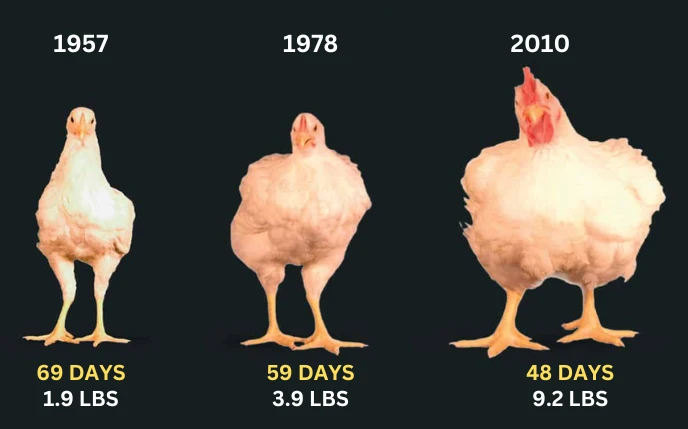Last year, a staggering 80 million chickens in the UK died before reaching slaughter weight, the highest mortality rate in at least a decade. This alarming figure, revealed through official statistics and highlighted in a report by Open Cages, an animal welfare campaign group, raises serious concerns over the welfare standards and breeding practices in the UK’s poultry industry.
The Root of the Problem: Fast-Growing Breeds
Animal welfare organizations attribute this high mortality rate to the predominant use of fast-growing chicken breeds in production. These breeds, often termed “Frankenchickens” by campaigners, suffer from higher rates of mortality, lameness, and muscle disease compared to their slower-growing counterparts. Connor Jackson, head of Open Cages, emphasized the scale of suffering, stating, “These figures highlight the shocking scale of suffering and death at the heart of the UK’s chicken industry.”

The Pressure on Commercial Chickens: Rapid Growth and Diet Manipulation
Commercial chickens have been selectively bred to grow at an unnaturally fast rate to meet market demand. This breeding for rapid growth often results in chickens reaching slaughter weight in just five to seven weeks, compared to the natural growth period of three to four months.
The accelerated growth rate puts immense strain on the birds’ hearts and skeletal structures, often leading to health complications and premature death.
Their diets are also manipulated to promote rapid growth, typically consisting of high-energy feeds rich in proteins, vitamins, and minerals. However, this forced growth through selective breeding and diet comes at a significant welfare cost.
A Call for Change: The Better Chicken Commitment
In response to these concerns, the RSPCA and other animal welfare groups are urging retailers to adopt the Better Chicken Commitment. This initiative, launched in early 2017, advocates for more space for birds and the use of slower-growing breeds. A spokesperson for the RSPCA said, “While the avian influenza outbreak will likely have impacted mortality rates in broilers, it is clear that such poor welfare standards and the use of fast-growing breeds will be contributing to the high mortality rate.”
Retailers like Waitrose and Marks & Spencer have signed up for this initiative. However, other major supermarkets have yet to commit, despite the growing outcry from animal welfare advocates.
More To Discover
- What Happens When There’s Less Wind To Power Our Turbines? Illinois’ Is Dealing With That Now.
- The Future of Eggs Is Here: Precision Fermentation Means Flocks Won’t Need To Produce Eggs
- Germany Invests $8 Billion to Rescue Key Green Energy Firm Amid Energy Transition
- The Hidden Giants Behind Vegan Brands Are The Meat And Dairy Industry Heavyweights
The Industry’s Stance and Challenges
The British Poultry Council argues that slow-growing breeds require more food and space, leading to greater environmental impact and potentially higher costs for consumers. Richard Griffiths, chief executive of the council, defends the industry, saying, “Our members consistently report mortality of below the 5% limit across all production types, so it is disingenuous to label one system or breed as better or worse.”
Government Response and Legislation
A spokesperson for the Department for Environment, Food & Rural Affairs emphasized the UK’s commitment to animal welfare, stating, “As the highest-ranked G7 nation on World Animal Protection’s Animal Protection Index, the UK is a world leader on animal welfare.” They acknowledged the impact of extreme heat events and avian influenza on mortality rates in 2022.
The Path Forward: Balancing Welfare and Production
This crisis in the UK’s chicken industry highlights a broader dilemma in modern agriculture: balancing animal welfare with production demands. As the industry grapples with these challenges, the voices of animal welfare organizations, industry leaders, and consumers will be crucial in shaping a more sustainable and ethical approach to poultry farming.




















